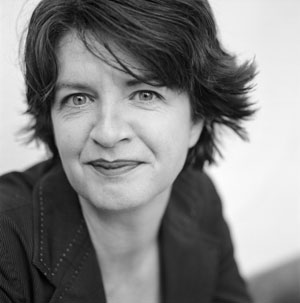Born in 1963 in the town of De Meern, in the Netherlands, Hella Jongerius is a Dutch designer who works with many different ceramic mediums. She studied industrial design at the Eindhoven Design Academy. Droog, an influential Dutch design collective, manufactured many of Jongerius’ early designs. From 1998-1999, Hella taught at the Design Academy in Eindhoven, where from 2000-2004 she served as head of the Department of Living/Atelier. In 2000 she founded the design studio JongeriusLab in Rotterdam where she creates, produces, and markets many of her designs such as dishware, vases, textiles, and furnishings. Hella’s work blurs the border between design and handicraft, or art and technology. In addition, she fuses traditional and contemporary influences through the use of high tech and low tech, as well as the industrial and artisanal themes. This juxtaposition is what distinguishes her style from other ceramic artists.
 When she first became interested in art and design she started off studying carpentry. But, she came to the conclusion that carpentry was too much about “making” and not enough about creating the actual design of the object. Therefore, Hella looked to industrial design where she could deal with practical questions about work and life that bordered a profession, which was the inspiration for her work. The main theme of her work is her craft. Her goal is to find ways to make unique pieces from industrial processes and use archetypal forms through new techniques or materials. A reoccurring theme is the fusion of craftsmanship with industrialization. Much of her work deals with the relationship between modernity and traditionalism. Take this teapot (to the right) for example. The top portion of the teapot displays classical antiquity that expresses traditional elements. Whereas the cosey that encompasses the base of the pot is structured with a more industrial approach. There is a combination of craftsmanship, which is evident in the hand-made cosey, and a traditional element with the classical bust that sits atop the teapot. She tends to create a capsule that obtains information about stories and layers that add to her ceramic works.
When she first became interested in art and design she started off studying carpentry. But, she came to the conclusion that carpentry was too much about “making” and not enough about creating the actual design of the object. Therefore, Hella looked to industrial design where she could deal with practical questions about work and life that bordered a profession, which was the inspiration for her work. The main theme of her work is her craft. Her goal is to find ways to make unique pieces from industrial processes and use archetypal forms through new techniques or materials. A reoccurring theme is the fusion of craftsmanship with industrialization. Much of her work deals with the relationship between modernity and traditionalism. Take this teapot (to the right) for example. The top portion of the teapot displays classical antiquity that expresses traditional elements. Whereas the cosey that encompasses the base of the pot is structured with a more industrial approach. There is a combination of craftsmanship, which is evident in the hand-made cosey, and a traditional element with the classical bust that sits atop the teapot. She tends to create a capsule that obtains information about stories and layers that add to her ceramic works.
Her work entitled Animal Bowls places greater emphasis on the manufacturers’ handcrafted products and shows the observer the numerous steps involved in finishing a product. What I love the most about this medium is the attention to detail. The animals that sit in the center of each vessel is oddly beautiful and precious in the sense that they are unexpected, but unusually functional. Both the “Unique Plates” and the bowls with animal figures are created exclusively by hand, not following defined patterns or matrices, but rather based on a system. Accordingly, no two plates are identical. They vary in size and depth and the marks left behind by the craftwork are made visible. This particular shape of the plate or the bowl is an archetypical concept that has existed for centuries and represents an attractive basis for a décor.
 Reflecting on historical ceramic works, Hella creates Prince and Princess. Her choice was for two of the museum’s most highly regarded pieces: a 14th century copper-red vase from China and a 15th century cobalt blue Ming vase, which inspired her to design her Prince and Princess ceramic works. Decorative forms such as dragons and flowers on these vases were used to allow for a new pattern of openwork. Hella Jongerius translates the age-old under-glaze technique by perforating the walls in a specific decorative pattern. She then fills the holes with colored silicon rubber. In this way, the perforated vases are made waterproof.
Reflecting on historical ceramic works, Hella creates Prince and Princess. Her choice was for two of the museum’s most highly regarded pieces: a 14th century copper-red vase from China and a 15th century cobalt blue Ming vase, which inspired her to design her Prince and Princess ceramic works. Decorative forms such as dragons and flowers on these vases were used to allow for a new pattern of openwork. Hella Jongerius translates the age-old under-glaze technique by perforating the walls in a specific decorative pattern. She then fills the holes with colored silicon rubber. In this way, the perforated vases are made waterproof.
As you can see, Hella produces a variety of works by different mediums through ceramics. It demonstrates the possibility of how far you can push a simple material like clay. Her work is extremely inspirational towards my work. I would love to emulate many of her techniques. I appreciate the simplicity of the majority of her work. She adds small, beautiful details that make her piece a gem in disguise.
Feel free to watch a YouTube video on Hella discussing her trials and tribulations of working chicle (a extremely new and challenging materials in the ceramics world). (click on "YouTube")















